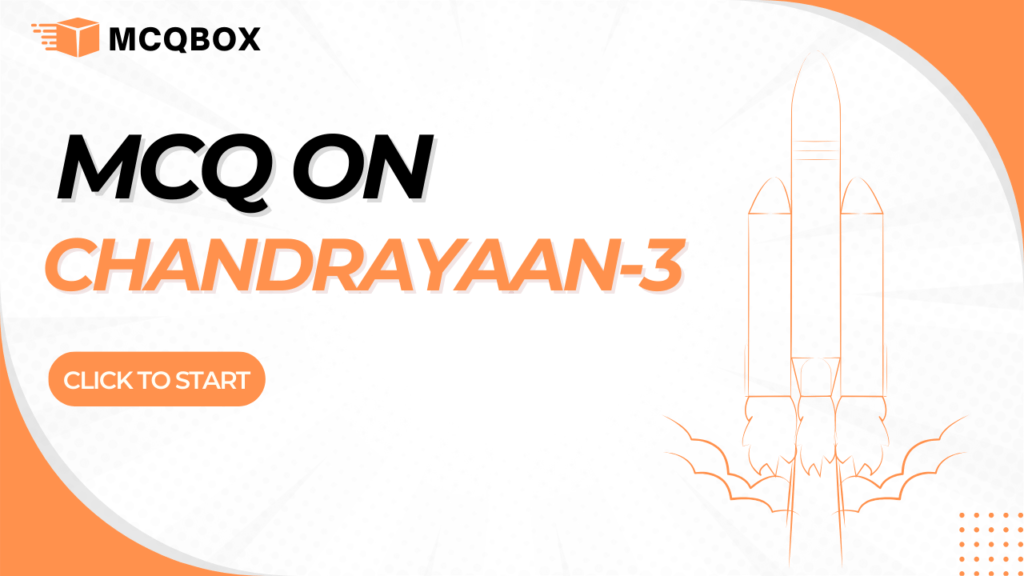Elevate your space knowledge with MCQ on Chandrayaan-3 for Competitive Exams 2024. Boost your exam prep and aim for the stars!

MCQ on Chandrayaan-3
1. When did Chandrayaan-3 make history by achieving a soft landing on the south pole of the moon?
a) August 23, 2021
b) June 23, 2022
c) August 23, 2023
d) None of these
Answer : c) August 23, 2023
2. What is the primary objective of the Chandrayaan-3 mission?
a) Orbiting Mars
b) Achieving a soft landing on the lunar surface
c) Studying Earth’s atmosphere
d) Exploring asteroids
Answer: b) Achieving a soft landing on the lunar surface
3. Which ISRO mission was launched before Chandrayaan-3 and ended in 2009 after communication loss?
a) Chandrayaan-1
b) Chandrayaan-2
c) Gaganyaan
d) Shukrayaan 1
Answer: a) Chandrayaan-1
4. What is the name of the lander and rover of the Chandrayaan-3 mission?
a) Voyager and Explorer
b) Eagle and Rover
c) Vikram and Pragyan
d) Luna and Lunar
Answer: c) Vikram and Pragyan
5. What instrument onboard Chandrayaan-3 monitored the lander’s speed during descent?
a) Laser Doppler Velocimeter
b) Spectro-polarimetry
c) Laser Retroreflector Array
d) Alpha Particle X-ray Spectrometer
Answer: a) Laser Doppler Velocimeter
6. Which technique confirmed the presence of sulphur on the Moon during Chandrayaan-3’s exploration?
a) Laser-Induced Breakdown Spectroscopy (LIBS)
b) Spectro-polarimetry
c) Laser Doppler Velocimeter
d) Alpha Particle X-ray Spectrometer (APXS)
Answer: a) Laser-Induced Breakdown Spectroscopy (LIBS)
7. What is the significance of the lunar south pole in the context of Chandrayaan-3’s mission?
a) It offers favorable terrain for landing.
b) It has extreme cold conditions up to -230 degrees Celsius.
c) It is easier to operate instruments due to sufficient sunlight.
d) It is the only region where water is present.
Answer: b) It has extreme cold conditions up to -230 degrees Celsius.
8. How did Chandrayaan-3 differ from Chandrayaan-2?
a) Chandrayaan-3 had fewer solar panels.
b) Chandrayaan-3’s landing area was expanded.
c) Chandrayaan-3’s lander had less fuel reserves.
d) Chandrayaan-3 did not have a rover.
Answer: b) Chandrayaan-3’s landing area was expanded.
9. What was the budget of the Chandrayaan-3 mission?
a) Rs 615 crore
b) Rs 500 crore
c) Rs 1,000 crore
d) Rs 200 crore
Answer: a) Rs 615 crore
10. How many solar panels does Chandrayaan-3’s lander have?
a) Two
b) Four
c) Six
d) Eight
Answer: b) Four
11. Why was the landing area expanded for Chandrayaan-3 compared to Chandrayaan-2?
a) To increase fuel reserves
b) To enhance instrument operation
c) To prevent potential mishaps
d) To accommodate more scientific payloads
Answer: c) To prevent potential mishaps
12. Which region of the Moon did Chandrayaan-3 target for its soft landing?
a) Equatorial region
b) North pole
c) South pole
d) Far side
Answer: c) South pole
13. Why is the south pole of the Moon considered significant for exploration?
a) Due to its favorable terrain
b) Because of extreme cold conditions
c) It may contain water and fossil records
d) It receives ample sunlight for solar power generation
Answer: c) It may contain water and fossil records
14. Which module of the Chandrayaan-3 mission was responsible for carrying the lander and rover configuration till 100 km lunar orbit?
a) Lander Module
b) Rover Module
c) Propulsion Module
d) Satellite Module
Answer: c) Propulsion Module
15. What is the primary objective of the Instrument for Lunar Seismic Activity (ILSA) payload onboard the Chandrayaan-3 lander?
a) To measure the thermal conductivity and temperature of the lunar surface
b) To estimate the plasma density and its variations
c) To study the seismicity around the landing site
d) To conduct in-situ scientific experiments on the Moon’s surface
Answer: c) To study the seismicity around the landing site